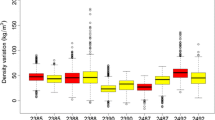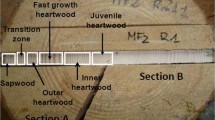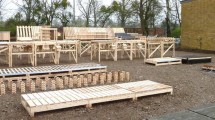Abstract
Within this study, the effect of different cross section dimensions on wood moisture content (MC), time of wetness (ToW), and fungal decay development of Norway spruce (Picea abies Karst.) and Scots pine sapwood (Pinus sylvestris L.) was examined. Specimens with ten different quadratic and rectangular cross sections were exposed horizontally in Hannover, Germany, and monitored for a period of 5 years. MC and temperature were recorded daily and data sets were submitted to a dose–response model based on material climatic data for evaluating the respective decay risk of the different specimen types. After 5 years of outdoor exposure timber dimension was found to be correlated neither with wood MC nor with decay development. However, time of wetness and decay were more severe in pine sapwood compared to spruce. Regarding onset and further development of decay, cracks as well as contact faces turned out to be weak points, but interior rot was observed as well. Brown rot, which occurred predominantly in the specimens, was partly difficult or even impossible to detect from the outside, but caused severe degradation also in small-dimensioned samples.





Similar content being viewed by others
References
Adachi K, Inoue M, Kawai S (2004) Liquid impregnation into dry wood using a roller-pressing method. II. Effect of specimen size and processing variables on amount of water impregnation. Mokuzai Gakaishi 50:243–247
Alfredsen G, Flæte PO, Kolstad S (2014) Norway spruce. Natural durable timber––field test results. IRG/WP Durability Database. Stockholm: The International Research Group on Wood Protection, IRG/WP/DDB 14-00080
Augusta, U (2007) Untersuchung der natürlichen Dauerhaftigkeit wirtschaftlich bedeutender Holzarten bei verschiedener Beanspruchung im Außenbereich. [Natural durability of European wood species in different use classes]. (In German) Doctoral thesis, University Hamburg, Faculty of Mathematics, Informatics and Natural Sciences, Department Biology, Germany
Austigard, M, Jenssen K, Mattsson J (2014) Decay damages in glulam beams as compared to solid wood logs. In: Wilson P (Ed) Proceedings of the 10th meeting of the Northern European network on wood science and engineering, 13–14th October 2014, Edinburgh, UK:73–78
Brischke C, Melcher E (2015) Performance of wax impregnated timber out of ground contact––results from long-term field testing. Wood Sci Technol 49:189–204
Brischke C, Meyer L, Bornemann T, Bilstein M, Lauenstein B, Lück J-M, Wulf C (2013) Service life of timber structures––prognosis based on 3 years high-frequency monitoring. Eur J Wood Prod 71:79–90
Brischke C, Rapp AO, Bayerbach R (2008) Measurement system for long-term moisture recording with internal conductively glued electrodes. Build Environ 43:1566–1574
Brischke C, Rolf-Kiel H (2010) Durability of European oak (Quercus spp.) in ground contact––A case study on fence posts in service. Eur J Wood Prod 68:129–137
Brischke C, Rapp AO (2010) Service life prediction of wooden components––Part 1: Determination of dose response functions for above ground decay. Stockholm: The International Research Group on Wood Protection, IRG/WP/10-20439
CEN/TS 12037 (2004) CEN/TS 12037 Wood preservatives––field test method for determining the relative protective effectiveness of a wood preservative exposed out of ground contact––Horizontal lap-joint method. CEN (European committee for standardization), Brussels
CEN (1990) EN 252 Durability of wood and wood-based products. Field test method for determining the relative protective effectiveness of a wood preservative in ground contact. CEN (European committee for standardization), Brussels
CEN (2015) EN 252 Durability of wood and wood-based products. Field test method for determining the relative protective effectiveness of a wood preservative in ground contact. CEN (European committee for standardization), Brussels
Cookson LJ, Page D, Singh T (2014) Accelerated aboveground decay testing in Australia and New Zealand. Int Biodeterior Biodegrad 86:210–217
Fojutowski A (2005) The influence of fungi causing blue––stain on absorptiveness of Scotch pine wood. Stockholm: The International Research Group on Wood Protection, IRG/WP/05-10565
Huckfeldt T, Schmidt O (2006) Hausfäule-und Bauholzpilze. [Indoor wood decay fungi]. (In German) Rudolf Müller, Cologne
Kalnins MA, Feist WC (1993) Increase in wettability of wood with weathering. Forest Prod J 43:55–57
Mehlich R-T (2009) Ermittlung der Feuchtebelastung an Holzbauteilen im Außenbereich in Abhängigkeit der Dimension. [Moisture loads of differently sized wooden components exposed outdoors]. (In German) Bachelor thesis, Leibniz University Hannover, Hannover
Meierhofer U, Sell J (1979) Physical phenomena in timber construction elements exposed to weathering. (In German) Holz Roh- Werkst 37:227–234
Metsä-Kortelainen S, Antikainen T, Viitaniemi P (2006) The water absorption of sapwood and heartwood of Scots pine and Norway spruce heat-treated at 170° C, 190° C, 210°C and 230° C. Holz Roh- Werkst 64:192–197
Meyer L, Brischke C (2015) Fungal decay at different moisture levels of selected European-grown wood species. Int Biodeterior Biodegradation 103:23–29
Meyer L, Brischke C, Kasselmann M, Roesmann C (2014) Moisture performance testing of wood––practical experiences. Stockholm: The International Research Group on Wood Protection, IRG/WP/14-20546
Meyer L, Brischke, C, Rieken J (2013) Testing the performance of timber using 27 different field test methods. Stockholm: The International Research Group on Wood Protection, IRG/WP/13-20517
Müller, J (2000) Konstruktiver Holzschutz durch die Gestaltung der Holzoberfläche unter Berücksichtigung der anatomischen Eigenschaften––Machbarkeitsstudie. [Wood protection by design under particular consideration of the wood surface and wood anatomy - A feasibility study] (In German) Final report Az. 08047. Deutsche Bundesstiftung Umwelt, Osnabrück:1–33
Rapp AO, Peek R-D (1999) Melamine resin treated as well as varnish coated and untreated solid wood during 2 years of natural weathering. (In German) Holz Roh- Werkst 57:331–339
Rydell Å, Bergström M, Elowson T (2005) Mass loss and moisture dynamics of Scots pine (Pinus sylvestris L.) exposed outdoors above ground in Sweden. Holzforschung 59:183–189
Saling WM (1930) The effect of blue stain on the penetration and absorption of preservatives. Proc Am Wood Pres Assoc 1930:183–197
Sandberg D (1999) Weathering of radial and tangential wood surfaces of pine and spruce. Holzforschung 53:355–364
Sandberg D (2005) Distortion and visible crack formation in green and seasoned timber: influence of annual ring orientation in the cross section. Holz Roh- Werkst 63:11–18
Sandberg K (2008) Degradation of Norway spruce (Picea abies) heartwood and sapwood during 5.5 years’ above-ground exposure. Wood Mat Sci Eng 3–4:83–93
Sandberg K, Mostolygin K, Hagman O (2013) Effect of lamellas annual-ring orientation on cracking of glulam beams investigated with computer tomography and image processing. Wood Mat Sci Eng 8:166–174
Sandberg D, Söderström O (2006) Crack formation due to weathering of radial and tangential sections of pine and spruce. Wood Mat Sci Eng 1:12–20
Sandberg K (2013) Moisture distribution in glulam beams with natural cracks observed with CT Scanning before and after rain. Stockholm: The International Research Group on Wood Protection, IRG/WP/13-20534
Schmidt O (2006) Wood and tree fungi. Biology, damage, protection, and use. Springer, Berlin, Heidelberg
Sell J (1980) Oberflächenbehandlung von Brettschichtholzträgern: Anforderungen, praktische Erfahrungen und Versuchsergebnisse. [Surface treatment of glulam: Requirements, practical experience and test results] (In German) Holz-Zentralblatt 106:629–630
Stienen T, Schmidt O, Huckfeldt T (2014) Wood decay by indoor basidiomycetes at different moisture and temperature. Holzforschung 68:9–15
Welzbacher CR, Rapp AO (2007) Durability of thermally modified timber from industrial-scale processes in different use classes: results from laboratory and field tests. Wood Mat Sci Eng 2:4–14
Zahora A, Jin L, Preston A (2013) Update on “Sandwich” type above ground field test methods. Stockholm: The International Research Group on Wood Protection, IRG/WP/13-20506
Acknowledgments
The authors are grateful for financial support of WoodWisdom-Net (www.woodwisdom.net) and wood industry partnership in the frame of the WWN project “Durable Timber Bridges DuraTB”. For help with the field trials the authors express their special thanks to Thomas Bornemann, Ralph-Thomas Mehlich, Carola Hesse and Christian Wulf.
Author information
Authors and Affiliations
Corresponding author
Rights and permissions
About this article
Cite this article
Brischke, C., Meyer-Veltrup, L. Moisture content and decay of differently sized wooden components during 5 years of outdoor exposure. Eur. J. Wood Prod. 73, 719–728 (2015). https://doi.org/10.1007/s00107-015-0960-7
Received:
Published:
Issue Date:
DOI: https://doi.org/10.1007/s00107-015-0960-7




